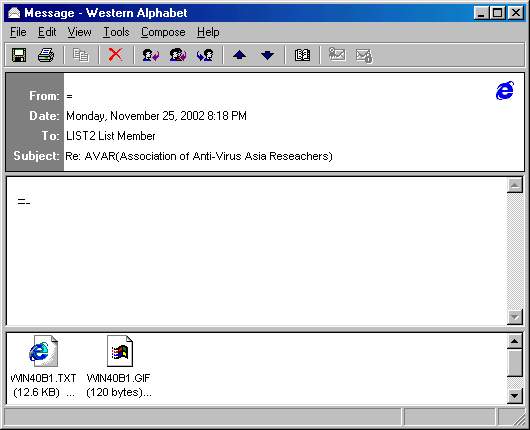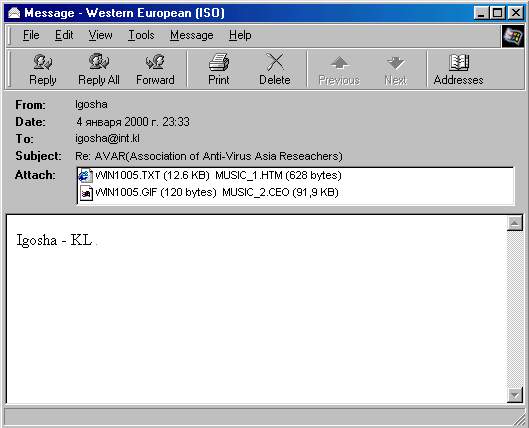Parent class: VirWare
Viruses and worms are malicious programs that self-replicate on computers or via computer networks without the user being aware; each subsequent copy of such malicious programs is also able to self-replicate. Malicious programs which spread via networks or infect remote machines when commanded to do so by the “owner” (e.g. Backdoors) or programs that create multiple copies that are unable to self-replicate are not part of the Viruses and Worms subclass. The main characteristic used to determine whether or not a program is classified as a separate behaviour within the Viruses and Worms subclass is how the program propagates (i.e. how the malicious program spreads copies of itself via local or network resources.) Most known worms are spread as files sent as email attachments, via a link to a web or FTP resource, via a link sent in an ICQ or IRC message, via P2P file sharing networks etc. Some worms spread as network packets; these directly penetrate the computer memory, and the worm code is then activated. Worms use the following techniques to penetrate remote computers and launch copies of themselves: social engineering (for example, an email message suggesting the user opens an attached file), exploiting network configuration errors (such as copying to a fully accessible disk), and exploiting loopholes in operating system and application security. Viruses can be divided in accordance with the method used to infect a computer:- file viruses
- boot sector viruses
- macro viruses
- script viruses
Class: Email-Worm
Email-Worms spread via email. The worm sends a copy of itself as an attachment to an email message or a link to its file on a network resource (e.g. a URL to an infected file on a compromised website or a hacker-owned website). In the first case, the worm code activates when the infected attachment is opened (launched). In the second case, the code is activated when the link to the infected file is opened. In both case, the result is the same: the worm code is activated. Email-Worms use a range of methods to send infected emails. The most common are: using a direct connection to a SMTP server using the email directory built into the worm’s code using MS Outlook services using Windows MAPI functions. Email-Worms use a number of different sources to find email addresses to which infected emails will be sent: the address book in MS Outlook a WAB address database .txt files stored on the hard drive: the worm can identify which strings in text files are email addresses emails in the inbox (some Email-Worms even “reply” to emails found in the inbox) Many Email-Worms use more than one of the sources listed above. There are also other sources of email addresses, such as address books associated with web-based email services.Read more
Platform: Win32
Win32 is an API on Windows NT-based operating systems (Windows XP, Windows 7, etc.) that supports execution of 32-bit applications. One of the most widespread programming platforms in the world.Description
Technical Details
This is the worm virus spreading via the Internet being attached to infected emails. The worm was found in-the-wild in Korea at the end of November 2002.
The worm itself is a Windows PE EXE file about 91Kb of length written in Microsoft Visual C++. Most of text strings in worm body are encrypted.
Installing
While installing the worm copies itself to Windows system directory with the random selected name:
WIN%rnd%.PIF
where %rnd% is random number, and registers that file in system registry auto-run key:
HKCUSoftwareMicrosoftWindowsCurrentVersionRun
HKLMSoftwareMicrosoftWindowsCurrentVersionRun
HKLMSoftwareMicrosoftWindowsCurrentVersionRunServices
There are two values written to all those keys:
.default = %worm file name%
%worm name% = %worm file name%
where %worm name% is worm file name without extentions, %worm file name% is full file name, for example:
.default = "C:\TEMP\WIND2C2.pif"
"WINA2B3" = "C:\WINDOWS\SYSTEM\WINA2B3.pif"
It seems that ".default" duplicate is written to registry key because of a bug in worm code.
Later the worm also copies itself with EXPLORER.PIF name to the Desktop.
Spreading
To get victim emails the worm looks for *.HTM and *.DBX files and extracts emails addresses from there except emails that have "@microsoft." part in email address. To send infected messages the worm uses direct connection to default SMTP server.
While sending itself the worm appends to its copy following information:
- country region ID (for example: [KOR], [RUS] - for Korea and Russia)
- current date and time
- user name and company name (as it is stored in registration information)
By using these data that is possible to trace particular worm copy "migration" process.
The infected messages have different data in email fields. Below the %RegisteredOwner% and %RegisteredOrganization%

Subject is randomly (depending on worm "generation") selected from variants:
Re: AVAR(Association of Anti-Virus Asia Reseachers)
N'4 %RegisteredOrganization%
N'4 Trand Microsoft Inc.

The last (third) variant is selected in case there is no "RegistreredOrganization" key in system registry. The "N`4" combination is not decrypted "Re:" string, it seems that the worm author just forgot to decrypt that string in corresponding routine.
The message body is also selected depending on worm generation:
%RegisteredOwner% - %RegisteredOrganization%
or:
AVAR(Association of Anti-Virus Asia Reseachers) - Report.
Invariably, Anti-Virus Program is very foolish.
Attached file names can be different, for example:
MUSIC_1.HTM, MUSIC_2.CEO
WIN40B1.TXT, WIN40B1.GIF
Where "WIN" names have random number at the end (in this case - "40B1"). At the same time depending on email client the appearence of these attached files in the infected message may be different.
To run from infected message the worm uses two security breaches:
Microsoft VM ActiveX Component
Incorrect MIME Header Can Cause IE to Execute E-mail Attachment
Payload
The worm looks for anti-virus programs, firewalls and debuggers and tries to terminate them, as well as to kill their files. In some cases (in all cases?) if an anti-virus is found, the worm erases all files on all drives, probably because of a mistake in its code.
The worm drops to Windows system directory "WIN%Rnd%.TMP" file, writes "Win32.Funlove" virus to there and executes this file. Thus the worm infects the machine with "Win32.Funlove" virus.
The worm displays the message:
Make a fool of oneself
What a foolish thing you have done!
In an endless loop the worm opens the http://www.symantec.com Web site (it seems that worm tries to run DoS attack on that server).
The worm also has following encrypted text strings:
~~ Drone Of StarCraft~~
http://www.sex.com/
Read more
Find out the statistics of the vulnerabilities spreading in your region on statistics.securelist.com